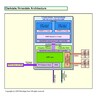Intel Core 2 Duo SL9400 vs Intel Core i5-540M vs Intel Core 2 Duo P7350
Intel Core 2 Duo SL9400
► remove from comparison
Der Core 2 Duo SL9400 ist ein stromsparender Low Voltage Prozessor für dünne und leichte Notebooks. Er bietet den vollen 6MB Level 2 Cache des Penryn Kerns und bietet dadurch eine bessere Performance als andere 1.86 GHz Core 2 Duo Prozessoren mit weniger Cache (1-3MB üblich). Im Vergleich zum SL9380 bietet der SL9400 einen schnelleren FSB mit 1066 MHz.
Intel Core i5-540M
► remove from comparison
Der Intel Core i5-540M ist ein zwei-Kern Prozessor für Notebooks und taktet dank Turbo mit 2.53 - 3.06 GHz. Die zwei Kerne basiert auf die Nehalem (Westmere) Mikro-Architektur und können dank Hyperthreading 4 Threads gleichzeitig abarbeiten.
Eine Besonderheit der neuen Dual-Core CPUs von Intel ist die Integration des Speichercontrollers und einer integrierten Grafikkarte (GMA HD) in das Package. Die CPU wird bereits in 32nm hergestellt, der Die für den Speichercontroller und die Grafikkarte jedoch noch in 45nm.
Die Performance des i5-540M liegt dank Turbo Boost im Schnitt oberhalb eines 2.8 GHz getakteten Core 2 Duo (z.B. P9700) und daher zählt der Core-i5 zu den schnellsten Dual-Core CPUs in 2010. Dank HyperThreading kann der 540M sogar langsam getaktete Quad Core CPUs in Multi-Threaded Anwendungen schlagen. Daher sollte der Prozessor für fast alle aktuellen Spiele und Anwendungen genügend Rechenleistung bieten (Anfang 2010).
Die 32-nm-Prozessorkerne der Westmere-Generation verarbeiten auch einige neue Befehle, die AES-Verschlüsselung beschleunigen sollen.
Die integrierte Intel Graphics Media Accelerator HD (GMA HD) Grafikkarte soll nach ersten Berichten mit bis zu 500-766 MHz getaktet werden (ev. auch mit Turbo Boost) und deutlich schneller werden als die alte GMA 4500MHD. Eine GeForce 9400M (ION) wird jedoch noch minimal schneller bleiben (mit besserem Treibersupport für Spiele).
Der Stromverbrauch ist mit einem TDP von 35 Watt zwar genauso hoch wie bei den T-Modellen der Core 2 Duo Serie, jedoch beinhaltet der TDP beim Core i5 auch die Grafikkarte und den Speichercontroller (beim Core 2 Duo waren diese noch im Chipsatz). Dadurch ist der Stromverbrauch des ganzen Systems wohl geringer. Unter Last wird der TDP durch den Turbo jedoch eher ausgereizt, wordurch der Stromverbrauch über vergleichbaren Core 2 Duo P-Modellen ausfallen kann (Idle deutlich darunter).
Intel Core 2 Duo P7350
► remove from comparisonDer Intel Core 2 Duo P7350 Dual-Core Prozessor bietet zwei Prozessorkerne mit einem gemeinsamen Level 2 Cache von 3 MB. Der Prozessor basiert auf den Penryn Kern und wird in 45nm gefertigt. Im Vergleich zu teureren Core 2 Duo Prozessoren, wurde jedoch beim P7350 die Virtualisierungsfunktion VT deaktiviert.
Durch die relativ geringe Taktrate von 2 GHz, ist die Performance bei manchen Spielen etwas begrenzt. Durch die schnelle Core 2 Duo Architektur, dem 1066 MHz getakteten FSB (effektiv) und den 3 MB Level 2 Cache, kann sich der P7350 gegenüber dem 2.4 GHz schnellen Turion X2 Ultra ZM-86 klar durchsetzen (bei geringerem Stromverbrauch der Intel CPU).
Der Penryn (Montevina Update) Kern bietet 2 Integer Units, 1 Floating Point Unit, 1 Load Unit und 1 Store Unit in einer 14-stufigen Pipeline. Mit der Wide Dynamic Execution Technologie kann der Kern bis zu vier volle Instruktionen gleichzeitig ausführen.
Dank Dynamic Acceleration (später Turbo Modus genannt), kann sich ein Kern um eine Stufe übertakten, wenn der zweite im Idle Modus (Leerlauf) ist.
Das integrierte Enhanced Speedstep kann die Taktfrequenz des Prozessors dynamisch an die Leistungsanforderungen anpassen. Dadurch läuft die CPU ohne Last nur mit 800 MHz.
Der Core 2 Duo P7350 passt in den Socket P (mit 479 Pins):
Socket P / Micro Flip-Chip Pin Grid Array (Micro-FCPGA) requires 479-pin surface mount Zero Insertion Force (ZIF) socket (mPGA479M socket) or Micro Flip-Chip Ball Grid Array (Micro-FCBGA) for surface mount (479-ball)
| Model | Intel Core 2 Duo SL9400 | Intel Core i5-540M | Intel Core 2 Duo P7350 | ||||||||||||||||||||||||||||||||||||||||||||||||||||
| Series | Intel Core 2 Duo | Intel Core i5 | Intel Core 2 Duo | ||||||||||||||||||||||||||||||||||||||||||||||||||||
| Codename | Penryn | Arrandale | Penryn | ||||||||||||||||||||||||||||||||||||||||||||||||||||
| Serie: Core 2 Duo Penryn |
| ||||||||||||||||||||||||||||||||||||||||||||||||||||||
| Clock | 1860 MHz | 2530 - 3066 MHz | 2000 MHz | ||||||||||||||||||||||||||||||||||||||||||||||||||||
| FSB | 1066 | 2500 | 1066 | ||||||||||||||||||||||||||||||||||||||||||||||||||||
| L2 Cache | 6 MB | 512 KB | 3 MB | ||||||||||||||||||||||||||||||||||||||||||||||||||||
| Cores / Threads | 2 / 2 | 2 / 4 | 2 / 2 | ||||||||||||||||||||||||||||||||||||||||||||||||||||
| TDP | 17 Watt | 35 Watt | 25 Watt | ||||||||||||||||||||||||||||||||||||||||||||||||||||
| Transistors | 410 Million | 382+177 Million | 410 Million | ||||||||||||||||||||||||||||||||||||||||||||||||||||
| Technology | 45 nm | 32 nm | 45 nm | ||||||||||||||||||||||||||||||||||||||||||||||||||||
| Voltage | 1.050V - 1.150V V | 1 - 1.25 V V | |||||||||||||||||||||||||||||||||||||||||||||||||||||
| Die Size | 107 mm2 | 81+114 mm2 | 107 mm2 | ||||||||||||||||||||||||||||||||||||||||||||||||||||
| max. Temp. | 105 °C | 105 °C | 90 °C | ||||||||||||||||||||||||||||||||||||||||||||||||||||
| Socket | BGA956 | BGA1288, PGA988 | Socket P | ||||||||||||||||||||||||||||||||||||||||||||||||||||
| Features | Enhanced Speedstep, Intel VT, TXT | Turbo Boost, Hyper Threading, Enhanced Speedstep, integrierte GMA HD 733MHz, | SSE4.1, Execute Disable Bit, Enhanced Speedstep, Ehnaced Halt State (C1E), 64 Bit, Trusted Execution Technology | ||||||||||||||||||||||||||||||||||||||||||||||||||||
| Architecture | x86 | x86 | x86 | ||||||||||||||||||||||||||||||||||||||||||||||||||||
| $284 U.S. | $257 U.S. | ||||||||||||||||||||||||||||||||||||||||||||||||||||||
| Announced | |||||||||||||||||||||||||||||||||||||||||||||||||||||||
| Manufacturer | ark.intel.com | ark.intel.com | ark.intel.com | ||||||||||||||||||||||||||||||||||||||||||||||||||||
| L1 Cache | 128 KB | 128 KB | |||||||||||||||||||||||||||||||||||||||||||||||||||||
| L3 Cache | 3 MB |


 Deutsch
Deutsch English
English Español
Español Français
Français Italiano
Italiano Nederlands
Nederlands Polski
Polski Português
Português Русский
Русский Türkçe
Türkçe Svenska
Svenska Chinese
Chinese Magyar
Magyar
